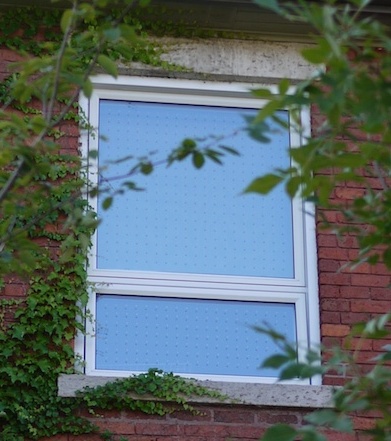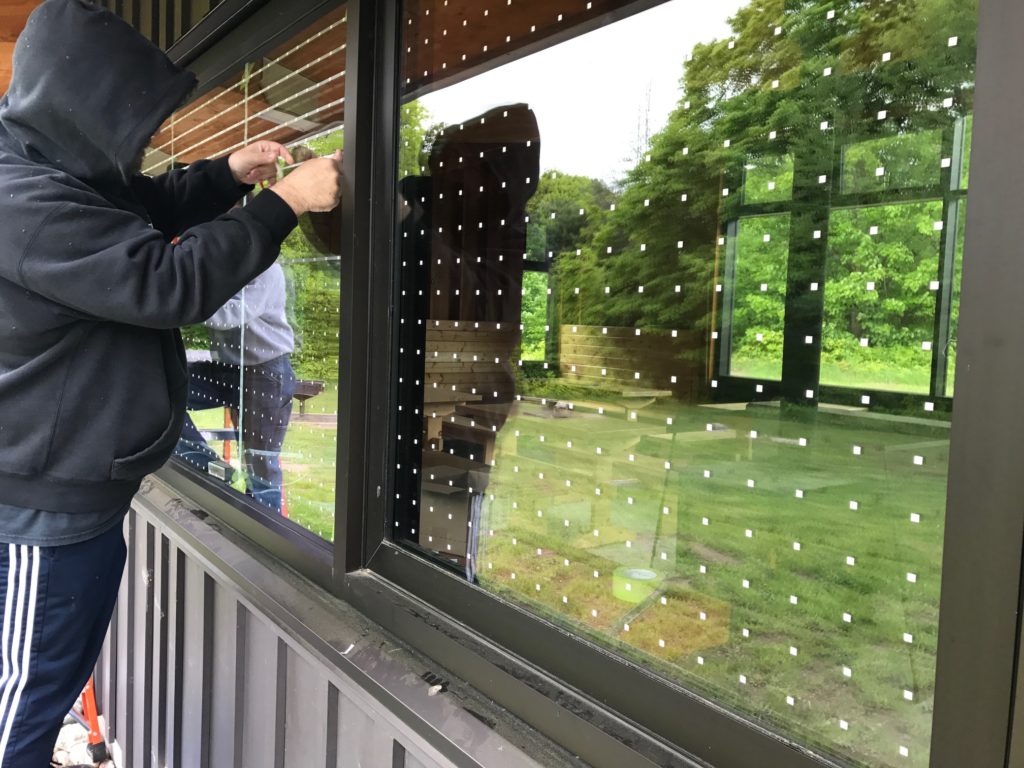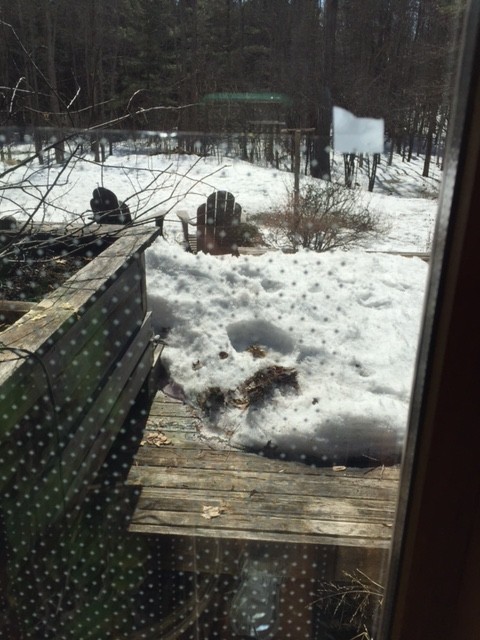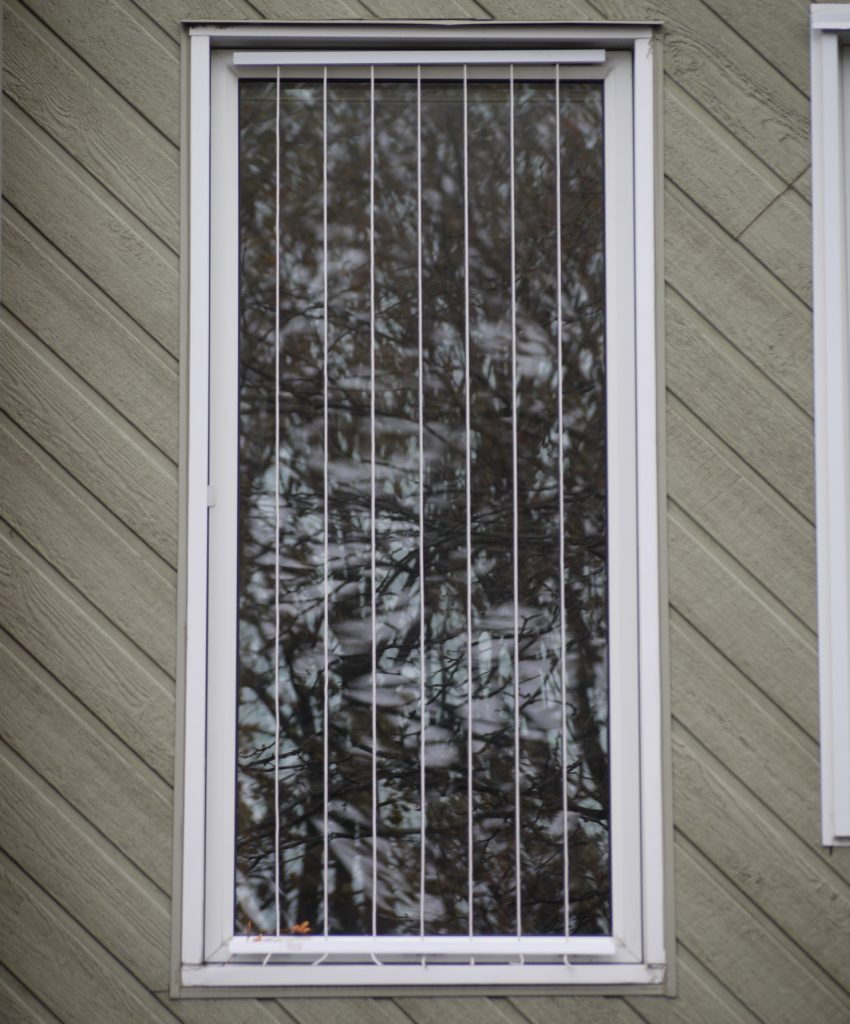 Bird collisions are not just a problem at large buildings. Did you know residences are responsible for 44% of collisions!
Bird collisions are not just a problem at large buildings. Did you know residences are responsible for 44% of collisions!
Many of these incidences go unnoticed because homeowners are away, in another room, or otherwise not aware when collisions occur. Dead or stunned birds are quickly picked off by neighbourhood cats or other creatures, or they fly away and die elsewhere.
Treating your windows and clear deck railings can save far more birds than you might think.
The key to preventing collisions is to make your windows visible to birds by applying visual markers in a dense pattern, ideally with a maximum gap of 5 cm (2″) between pattern elements, on the exterior surface of the glass.
If you are replacing your windows, doing a major renovation or building a new home, opt for bird-friendly glass products.
Click here to find out what DOES NOT work

Solutions for small projects
The following reasonably priced collision deterrence products are available for existing buildings. You may also want to explore these solutions for large projects, or contact a local installer directly.
In choosing a solution, consider not only the price, but also the effectiveness and expected lifespan of the product. It’s better to spend a bit more money and effort installing a product if it will last years.
Feather Friendly Visual Marker Tape
Adhesive dots applied to the outside of your windows create a pattern that prevents collisions. It comes on a roll of tape, which peels off to leave behind a grid of subtle white or black dots in a 5 cm (2″) grid pattern. Feather Friendly tape, highly recommended for its aesthetic appeal and longevity, is available directly from Safe Wings Ottawa (email info@safewings.ca or call 613-216-8999), from the manufacturer online, or retail at Wild Birds Unlimited Ottawa (1500 Bank St), Wild Birds Unlimited Kanata (420 Hazeldean Rd), Gilligallou Bird (14 Mill St in Almonte), Lee Valley Tools (900 Morrison Dr), and Ritchie Feed & Seed (Ottawa East, Richmond, Stittsville, Brockville, Petawawa).
Feather Friendly (featherfriendly.com) also has commercial products available in different styles, applied as a sheet of film that’s then peeled off. Choose a pattern with 5 cm (2″) spacing for maximum effectiveness.
Acopian BirdSavers
Made of lengths of parachute cord hanging from a horizontal crosspiece, Acopian BirdSavers are easy to install and long lasting. The cords are spaced 11 cm (4 1/4″) apart, which because of wind movement and shadows is more effective than a static pattern at that spacing. If you make your own, you can reduce the spacing a little to increase their effectiveness for small birds. The Acopian website gives directions to build your own, or order them to size online. The original design lets the cords hang loose. The ones pictured here are made with inexpensive, 1/8″ nylon cord attached to vinyl J-channel top and bottom for a cleaner look. The whole unit is attached to the casement window with industrial-strength Velcro. Larger windows may do better with more rigid aluminum J-channel or U-channel, affixed with hooks or screws.
Bird Screens
Screens provide a flexible barrier and visual noise between windows and birds. If installed taut, with a 5 cm (2″) gap between glass and screen, they will also cushion birds from potential impacts. Standard screens have black top and bottom frames, black fiberglass screening (replaceable), and are attached to the top of the window by screw hooks and/or suction cup brackets.
CollidEscape
Perforated window film (a.k.a. bus wrap), can be applied as a solid sheet, printed with a design, tinted, or in cutout patterns. It appears opaque from the outside in daylight, and like a screen from inside. The standard product is equivalent to a 50% window tint, and blocks heat and UV light while preventing collisions. However, the product will appear transparent at night from outside if the building is lit from within, which renders it ineffective against nighttime collisions.
CollidEscape is marketed specifically for bird collisions, but any perforated film will be effective, although it may not last as long, especially if unlaminated. We do not recommend CollidEscape Clear.
Oil-based paint markers
Draw or stencil an opaque design (stripes, dots or anything else) on the outside of the window using a bold-tip oil-based paint marker (e.g. Sharpie Oil-Based Paint Markers). Make sure your pattern elements are no more than 5 cm apart, and choose a high-contrast colour, such as white, that will be visible under a wide range of light conditions. Oil-based paint will last a very long time, but can be scraped off if necessary.
Santa Rosa National Crash Preventers
Barriers of monofilament nylon lines attached to metal tubing, and offset from the window. The effectiveness of this product is not well known. The wires are very thin, spaced 3″ apart, and there is a risk that birds could get tangled in the lines.
Solyx Bird Safety Film
External window film available in horizontal and vertical stripes. May require professional installation.
Vinyl automotive tape
Vinyl pinstriping tape, normally used to trim cars, is a low-cost, long-lasting product that can effectively prevent collisions. It does not stretch the way similar-looking tapes might, making it much easier to apply in straight lines. Use high-contrast tape at least 6 mm (1/4″) wide at 5 cm (2″) spacing. Oracal 651 and Trimbrite are two examples.
 Not recommended: WindowAlert and other UV products
Not recommended: WindowAlert and other UV products
While UV decals and similar products are very popular and readily available, we do not recommend them for the following reasons:
- Any visual markers are only effective when applied a maximum 5 cm (2″) apart vertically and horizontally. The WindowAlert instructions state, “Place decals alone or in groups every few feet”.
- Products (including special glass) that rely on reflected UV light to deter collisions are not sufficiently effective because not all birds species can see UV light, and because UV light is weakest early in the morning, when most collisions occur.
- UV decals fade quickly and must be replaced often.
- UV liquid is runny and not visible enough.
- Required density and frequency of replacement render this product more costly in the long run compared with more effective alternatives.
 Cheap & cheerful
Cheap & cheerful
Consider these temporary measures to prevent collisions until you can apply a more permanent solution:
- Decorate windows with a chalk marker or tempera paint applied with a brush, sponge or stencil. Both can be wiped off with a damp rag or sponge.
- Apply frosted or patterned/decorative window film, available at most home improvement stores.
- Tape densely patterned cellophane wrapping to the exterior of the window, available at most dollar stores.
- Hang lengths of ribbon, string or parachute cord in front of windows, spaced 5 cm – 10 cm (2 – 4″) apart.
- Stretch lightweight netting or screening across the outside of your windows, leaving at least 5 cm (2″) of space between the netting and glass. Make sure the material is stretched taut and check periodically. Loose or torn netting may result in birds and other wildlife getting tangled.
- Apply decals or stickers in a dense pattern; too much space between decals will significantly reduce their effectiveness.
- “Paint” windows with soap, erasable marker or a highlighter pen, reapply after rain.
- Apply whitewash to windows (made from hydrated lime powder from the hardware store).
Other strategies
- Relocate bird feeders and bird baths to less than 50 cm (1 1/2 feet) from windows. This prevents birds from colliding with windows at high speed if they flee a predator at the feeder.
- Close curtains or blinds to reduce clear views through opposite or adjacent windows. This can eliminate see-through effects but not reflections.
- Move houseplants away from windows or hang sheer curtains so birds can’t easily see the greenery.
For additional information, visit the American Bird Conservancy and Fatal Light Awareness Program websites.






